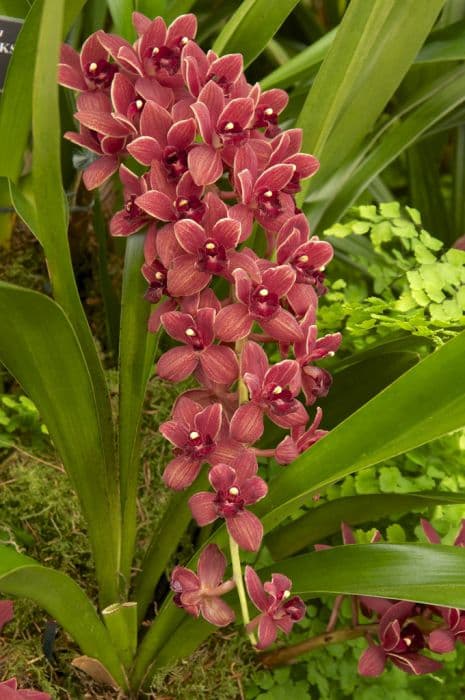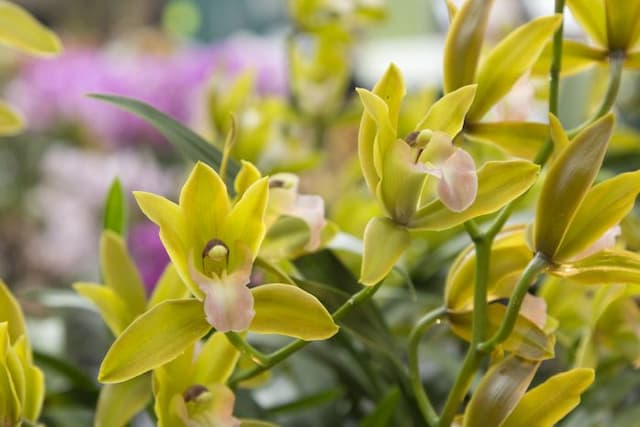Boat Orchid Cymbidium 'Cali Night'

ABOUT
The Cymbidium 'Cali Night', commonly known as a type of orchid, is noted for its striking appearance. This plant boasts long, arching leaves that are deep green in color, providing an elegant backdrop to its distinctive blooms. The flowers of the 'Cali Night' orchid are particularly remarkable; they display a rich color palette that typically includes deep, velvety shades ranging from maroon to almost black, which is unusual and highly sought after among orchid enthusiasts. Each flower has a complex structure with multiple petals that are broad and rounded, arranged in a symmetrical pattern around a central column. The petals may have a somewhat waxy texture and can have varying hues, often with contrasting colors or patterns, such as spots or stripes, that add to their visual appeal. The blossoms are arranged on sturdy stems that emerge from the base of the plant, creating a dramatic display when the plant is in bloom. The overall allure of the Cymbidium 'Cali Night' orchid lies in the combination of its graceful foliage and the exotic, dark beauty of its flowers, which together create an almost mystical presence that can add elegance and a touch of the dramatic to any collection of houseplants or orchids. Despite its exotic looks, it is quite popular among gardeners and plant lovers for its durability and relatively straightforward care requirements.
About this plant
 Names
NamesSynonyms
Cymbidium, Boat Orchid
Common names
Cymbidium 'Cali Night'.
 Toxicity
ToxicityTo humans
The boat orchid, Cymbidium 'Cali Night', is generally considered non-toxic to humans. Therefore, ingesting parts of this plant typically does not result in poisoning or adverse health effects. However, individual sensitivities can vary, and consuming any non-food plant can potentially cause mild stomach upset or an allergic reaction in some people. The symptoms of such a reaction could include itching, swelling, or digestive discomfort, but this is not common.
To pets
The boat orchid, Cymbidium 'Cali Night', is generally considered non-toxic to pets such as dogs and cats. Ingesting parts of this plant should not cause poisoning or serious health issues in pets. However, as with humans, individual animals may experience mild gastrointestinal upset if they consume the plant, which could lead to symptoms like vomiting or diarrhea. These are not typical reactions and usually, no significant consequences are expected.
 Characteristics
CharacteristicsLife cycle
Perennials
Foliage type
Evergreen
Color of leaves
Green
Flower color
Varies
Height
2 feet [0.61 meters]
Spread
2 feet [0.61 meters]
Plant type
Bulb
Hardiness zones
10
Native area
Asia
Benefits
 General Benefits
General Benefits- Aesthetic Appeal: Cymbidium orchids, such as the 'Cali Night', add an elegant and exotic touch to any environment with their striking flowers and lush foliage.
- Long-Lasting Blooms: The flowers of the Cymbidium 'Cali Night' can last for several weeks, providing a long period of enjoyment.
- Symbolic Meaning: Orchids are often associated with love, beauty, and strength, making them meaningful gifts and decor elements.
- Variety of Colors: 'Cali Night' offers a unique color variation that can complement various design schemes and personal preferences.
- Therapeutic Gardening: Caring for orchids like the 'Cali Night' can provide a sense of achievement and stress relief as part of therapeutic gardening activities.
 Medical Properties
Medical PropertiesThis plant is not used for medical purposes.
 Air-purifying Qualities
Air-purifying QualitiesThis plant is not specifically known for air purifying qualities.
 Other Uses
Other Uses- Cymbidium orchids can be used as a natural fabric dye, providing a range of colors depending on the parts of the plant used and the mordant applied during the dyeing process.
- The long-lasting flowers of Cymbidium orchids can be used as natural decorations on cakes and pastries, especially for elegant or botanical-themed events.
- These orchids can be pressed and used in botanical art or herbarium collections as a way of preserving their beauty and studying their structure.
- The sturdy leaves of the Cymbidium orchid can be woven together to create small, decorative items such as bookmarks or coasters.
- Petals of Cymbidium orchids are sometimes used in creating personalized perfumes or natural potpourris due to their unique and pleasant scent.
- As a teaching tool, the intricate structures of Cymbidium orchids can be used to educate people about orchid pollination and plant biology.
- Plants of the Cymbidium genus are often used in aquariums as part of aquascaping to provide an aesthetic aspect and potentially to offer hiding places for small fish or shrimp.
- Leaf litter from Cymbidium orchids can be composted and used as a soil amendment to enrich garden beds or potted plant mixtures.
- During celebrations or in rituals in some cultures, Cymbidium orchid flowers are used as offerings or decorations to symbolize respect and honor.
- Cymbidium orchid blooms can be used in the crafting of floral jewelry, such as earrings or pendants, often by drying and then encasing them in resin.
Interesting Facts
 Feng Shui
Feng ShuiThe Cymbidium orchid is often used in Feng Shui for its properties of promoting serenity and purity. To utilize this plant, it should be placed in an area of the home like the living room where it can enhance the flow of Chi, promoting tranquility and familial harmony. Choose a pot color that corresponds with the Feng Shui element you want to amplify, such as earth tones for stability and growth, or metal tones for creativity and mental clarity.
 Zodiac Sign Compitability
Zodiac Sign CompitabilityThe Cymbidium orchid is not used in astrology practice.
 Plant Symbolism
Plant Symbolism- Love and Affection: Cymbidium orchids, commonly known as Boat Orchids, often symbolize love and affection, making them a popular gift for romantic occasions.
- Beauty: With their striking appearance, Boat Orchids are associated with beauty and refinement.
- Strength and Nobility: Historically, these orchids were related to strength and nobility, as they were prized possessions among the wealthy during the Victorian era.
- Longevity: Boat Orchids have long-lasting flowers, and they are often seen as a symbol of longevity and a life well-lived.
 Water
WaterThe Cymbidium orchid should be watered thoroughly once the top inch of the potting media feels dry to the touch. Typically, this will be about once a week, but the frequency may increase during the warmer months or if the environment is particularly dry. During each watering, allow water to run through the potting media until it drains out the bottom, using approximately one-quarter to one-half gallon of water depending on the size of the pot. It's important to avoid letting the plant sit in standing water, as this can lead to root rot. Reduce watering in the cooler months to prevent stagnation and possible fungal issues.
 Light
LightCymbidium orchids prefer bright, indirect light. They can benefit from some direct morning sun but should be shielded from the harsh afternoon sun to prevent leaf burn. An ideal spot would be a location with east-facing windows or a shaded southern or western exposure. Providing adequate light is crucial for flower production and overall plant health.
 Temperature
TemperatureThe ideal temperature range for Cymbidium orchids is between 50 to 70 degrees Fahrenheit during the day and 40 to 50 degrees at night. They can tolerate temperatures as low as 35 degrees and as high as 85 degrees for short periods, but prolonged exposure to extremes outside the ideal range can be detrimental. Ensuring a slight drop in night temperature is key to triggering the blooming cycle.
 Pruning
PruningPruning Cymbidium orchids is necessary to remove spent flower spikes and encourage new growth. After the orchid has finished blooming, usually in the late spring, cut the flower spike close to the base using sterilized pruning shears. This is also a good time to remove any dead or yellowing leaves. Pruning is not done very often, usually only once a year after the bloom cycle.
 Cleaning
CleaningAs needed
 Soil
SoilThe best soil mix for Cymbidium orchids, also known as 'boat orchids', should be well-draining and slightly acidic, with a pH around 5.5-6.5. A common recipe could be a blend of bark, perlite, and peat, which provides good aeration and drainage. This ensures that the roots do not become waterlogged and promotes healthy growth.
 Repotting
RepottingBoat orchids should be repotted every two to three years to refresh the growing medium. Repotting is typically done after the orchid has finished flowering, to provide fresh nutrients and to address any issues with the previous potting mix. However, if the orchid is growing well, repotting might only be necessary when the plant outgrows its pot.
 Humidity & Misting
Humidity & MistingBoat orchids thrive in environments with high humidity, ideally between 40% and 60%. Maintaining these humidity levels can be achieved by placing a humidifier near the plant or by setting the pot on a tray filled with water and pebbles to create a more humid microclimate around the orchid.
 Suitable locations
Suitable locationsIndoor
Place in bright, indirect light and ensure high humidity.
Outdoor
Shelter from direct sun; mist daily for humidity.
Hardiness zone
9-11 USDA
 Life cycle
Life cycleThe Cymbidium 'Cali Night', also known as the Cymbidium Orchid, begins its life cycle as a seed, often requiring specialized fungi to germinate and grow. Seedlings develop into plants with pseudobulbs, which are storage organs for nutrients, and from these pseudobulbs, the plant produces long, strap-like leaves. Over time, the orchid matures and develops a flower spike, featuring the characteristic beautiful and exotic, usually fragrant, flowers that can come in a variety of colors, often blooming in the late winter or spring. After the flowering stage, the blooms last several weeks before wilting; however, the orchid can rebloom from the same spike in subsequent years if it is not removed. In its perennial life cycle, the Cymbidium Orchid enters a dormant period following blooming, during which it requires less water and no fertilizer. With proper care, including a period of cooler temperatures to initiate flowering, the cycle repeats annually, with the plant potentially living and blooming for many years.
 Propogation
PropogationPropogation time
Spring-Early Summer
The Cymbidium orchid, commonly known as the 'Cali Night', is typically propagated through division, which is the process of separating a mature plant into smaller sections. This method is most successful when performed just after the orchid has finished flowering, which generally occurs in the spring. The orchid clumps are carefully taken out of the pot and the roots are cleaned of any old media. Divisions are then made with a sterile cutting tool, ensuring that each new section has at least three to four healthy pseudobulbs. The divisions are then potted in fresh orchid potting mix, with care taken to ensure that the uppermost roots are just below the surface of the media. It's important to maintain high humidity and moderate light to encourage the newly divided orchids to establish themselves.









